 |
 |
| World - Tea Production Map |
India - Tea Production Map |
Varieties
Pandian, Sundaram, Golconda, Jayaram, Evergreen, Athrey, Brookeland, BSS 1, BSS 2, BSS 3, BSS 4, BSS 5, Biclonal seed stocks and Grafts.
 |
 |
| Tea Bush |
Tea Flower |
| Tea cultivars with special characters |
| S.No |
Special characters |
Clone |
Originators |
| 1 |
Wind Tolerance |
UPASI-2 UPASI-10 |
UPASI-TRF India |
| 2 |
Drought resistance |
UPASI-9 |
UPASI-TRF India |
| 3 |
Frost resistance |
B-26 |
HPKV-TES India |
| 4 |
Smallest leaf |
CH-1 |
IHBT India |
| 5 |
Biggest Leaf |
Betjan |
BETJAN T.E, India |
| 6 |
Blister blight tolerance |
TRI-2043, |
TRI, Sri Lanka |
| 7 |
High pubescence |
TRI-2043 |
TRI, Sri Lanka |
| 8 |
High anthocyanin pigmentation |
TRI-2025 |
TRI Sri Lanka |
| 9 |
High tolerance to pH |
TN-14-3 |
TRF, Kenya |
| 10 |
Poor fermenter |
12/2 |
TRF, Kenya |
| 11 |
Mite tolerance |
7/9 |
TRF, Kenya |
| 12 |
Scale insect tolerance |
TN-14-3 |
TRF, Kenya |
| 13 |
High polyphenol content (53.7%) |
Luxi white tea |
TRI, China |
| 14 |
High amino acid content (6.5%) |
Anji white tea |
TRI, China |
| 15 |
Low caffeine content (0.14%) |
Guangdong tea |
TRI, China |
| 16 |
High caffeine content (6.96%) |
Wild tea at Yunnan |
TRI, China |
| 17 |
Water logging tolerance |
TV-9 |
TES, India |
| (Mondal et al., 2004) |
| Improved clones |
| S.No |
Clone |
Important features |
| 1 |
UPASI 1 (Ever green) |
Hardy, Quality-Above average |
| 2 |
UPASI 2 (Jayaram) |
Hardy, Quality-Above average, tolerant to drought and wind |
| 3 |
UPASI 3 (Sundaram) |
Natural triploid quality clones and very high yielding |
| 4 |
UPASI 6 (Brooklands) |
Suited to mid and higher elevations |
| 5 |
UPASI 8 (Golconda) |
Suited to all elevations, high yielding |
| 6 |
UPASI 9 (Arthrey) |
Firly tolerant to drought and withstand slightly high pH, , high yielding |
| 7 |
UPASI 10 (Pandian) |
Hardy, Quality-Above average, tolerant to drought and wind |
| 8 |
UPASI 14 (Singara) |
Suited to higher elevations , High yield |
| 9 |
UPASI 15 (Spring field) |
Flushes throughout the year |
| 10 |
UPASI 17 (Swarna) |
Flourishing well at mid and high elevations |
| 11 |
UPASI 24 |
Hardy |
| 12 |
UPASI 25 |
High yielding |
| 13 |
UPASI 16 |
High yielding |
| 14 |
UPASI 27 |
Drought tolerant |
| 15 |
UPASI 28 (UPASI 10 * TRI2025) |
Biclonal, Good strength and high quality |
Soil and climate
Tea requires well drained soil with high amount of organic matter and pH 4.5 to 5.5. The performance of tea is excellent at elevations ranging from 1000 - 2500 m.Optimum temperature: 20 - 270 C.
Nursery
The nursery soil should be well drained and deep loam in nature with pH of 4.5 to 4.8. The soil and sand used in the preparation of rooting medium should be tested for pH and nematode infestation. |
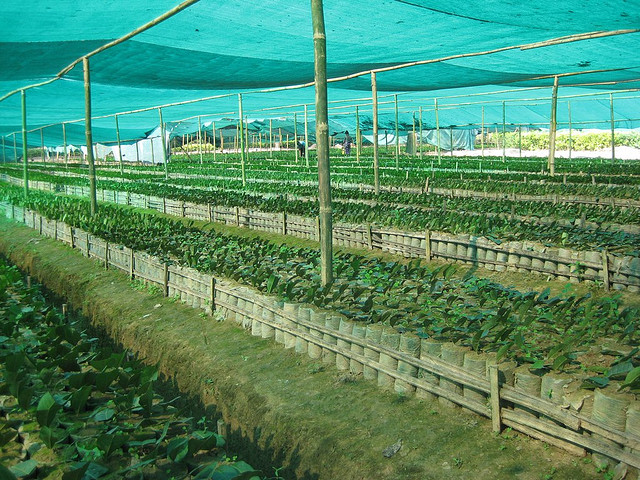 |
 |
Nursery |
|
 |
 |
| Artificial Shade by Erecting Pandal |
Polythene Tent with Tea Seedllings |
|
Pre-treatment of rooting medium
Treating with Aluminium sulphate can reduce soil pH. For this purpose the nursery soil is formed into beds of one metre width and about 8 cm height and of a convenient length. Then the beds are drenched with 2% solution of Aluminium sulphate applied at 10 litres/2.5 sq.m of area. Over this another layer of soil of 8 cm height is spread and again drenched with equal quantity of water twice. Then the soil is allowed to dry and the pH is checked before use in the nursery.
Preparation of sleeves
Polythene sleeves of 150 or 200 gauge and 10 cm width and 30 - 45 cm length may be used. Drainage holes may be provided at the bottom. The lower 3/4 of the sleeves should be filled with 1:3 sand and soil mixture and the top 1/4 with 1:1 sand and soil mixture and staked in rows. Overhead shade is provided.
|
Selection of mother bush and its treatment
Healthy and vigorously growing high yielding bushes should be selected. Apply to each selected bush with 40 g of young tea mixture + 60:90 NK mixture up to 5 years. The following mixture has to applied before taking the cuttings.
- 0.5 % AlSO4 + 1 % MgSO4 (before 3 weeks)
- 2 % Zn SO4 (before 2 weeks)
- 1 % Urea (before 1 week)
Preparation of cuttingsCuttings are taken on April - May and August - September. Semi hard-wood cuttings are prepared with one leaf and an internode with a slanting cut at the bottom.
Planting of cuttings
The sleeves are watered thoroughly and holes are made in the soil. The cuttings are inserted in the hole and the soil around is pressed firmly to avoid airspace followed by watering. Small polythene tents may be provided which maintain high humidity and regulate the temperature inside. Cuttings may take 10 - 12 weeks for rooting. After 90 days i.e. when all the cuttings have rooted, the polythene tent may be removed gradually over a period of 10 - 15 days.
Manuring of nursery
After the tent is removed the cuttings are sorted and staked. 30 g of Nursery soluble mixture of the following composition dissolved in 10 litres of water may be applied over an area of 4 sq.m. This should be done fortnightly.
Composition of the fertilizer
Ammonium phosphate (20:20) 35 parts by Wt
Potassium sulphate 15 parts by Wt
(or)
MOP 12 parts by Wt
Magnesium sulphate 15 parts by Wt
Zinc sulphate 3 parts by Wt
Total 80 parts by Wt
Hardening of the cuttings
Hardening of 4 - 6 months old young cuttings should be done by removing shade gradually in stages over a period of 4 - 6 weeks starting from a few hours exposure to sun every day initially and extending the time of exposure gradually.
Methods of planting
Single Hedge System
In this method, the spacing adopted is 1.20 x 0.75 m accommodating 10,800 plants/ha.
Double Hedge System
In this method, the spacing adopted is 1.35 x 0.75 x 0.75 m accommodating 13,200 plants/ha.
Season and planting
May - June or September - October
Sleeves should be opened lengthwise without injuring the roots and planted in the pit and the soil is gently pressed.
Irrigation
Subsoil irrigation may be given for young tea seedlings during summer months.
|
 |
| Vegetative Propagation |
|
Manuring
Manuring should be done 2 months after planting. Phosphorous should be applied at 80 - 100 kg/ha as Rock phosphate once in a year by placement at 15 - 25 cm depth up to the first pruning and thereafter once in two years. N : K ratio 2 : 3 should be adapted for the first 3 years and a ratio 1 : 1 thereafter.
| Year of application |
Total weight kg/ha/annum |
No. of applications |
Qty/plant (g) |
| N |
K |
Ammonium Sulphate |
Urea |
| I year |
180 |
270 |
5 |
13 |
27 |
| II year |
240 |
360 |
6 |
23 |
15 |
| III year |
300 |
450 |
6 |
29 |
18 |
| IV year onwards |
300 |
300 |
6 |
33 |
19 |
Application of fertilizers should be done before the onset of monsoon. Fertilizers should be broadcast around the drip circle avoiding contact with the collar.
Aftercultivation
Perennial grasses (Forbicot weeds) can be controlled by spraying Glyphosate 1.75 lit + Kaoline 2 lit + 2 kg of wetting agent in 450 lit. of water followed by Gramoxone 500 ml in 200 lit of water to control dicot weeds.
Training young tea
Centering
To induce more laterals, centering should be done 3 - 5 months after planting. The main leader stem should be cut, leaving 8 - 10 matured leaves.
Tipping
Tipping is done at a height of 35 cm from the second tipping at 60 cm from ground level.
Pruning
Pruning is done to maintain convenient height of bush and to remove dead and diseased branches.
Area to be pruned every year = Total extent of the garden
Pruning cycle
Pruning interval = (Elevation in feet / 1000) + 1
Pruning should be done in April - May or August - September.
Types of pruning
Rejuvenation pruning
The whole bush should be cut near the ground level less than 30 cm with a view to rejuvenate the bushes.
Hard pruning
Hard/ formation pruning of young tea is done at 30 to 45 cm (12" to 18") for proper spread of bushes.
Medium pruning
To check the bush growing to an inconvenient height this type of pruning is done in order to stimulate new wood and to maintain the foliage at lower levels less than 60 cm.
Light pruning
Pruning depends on the previous history of the bush raising the height of medium pruning by an inch or less to manageable heights for plucking (less than 65 cm).
Skiffing
This is the lightest of all pruning methods. A removal of only the top 5 - 8 cm new growth is done so as to obtain a uniform level of pruning surface (more than 65 cm).
 |
Pruned Plant |
Shade regulation
Pollarding of shade trees should be done prior to heavy rains at a height of 8 - 10 m from the ground level.
 |
Shade Trees |
Annual lopping
Cutting the erect type branches on the laterals in shade trees before monsoon season.
Plant protection
Scales
Scales can be controlled by spraying Carbaryl 50 WP @ 2 g/lit.
Sahydrassis / Phassus borer
Locate the particle mat covering at the base tea bush and remove.
Insert a thick wire in the bore hole to kill the larvae.
Thrips
Spray any one of the following insecticide
Insecticide |
Dose |
Azadirachtin 5 % Neem extract concentrate |
5.0 ml/10 lit. |
Azadirachtin 1.0 % EC (neem based) |
2.0 ml/lit. |
Ethion 50%EC |
5.0 ml/10 lit. |
Profenofos 50 % EC |
2.0 ml/lit. |
Aphids
Spray phosalone 35 % EC @ 2.0 ml/lit
Red spider mite, Pinkmite, scarlet mite
Insecticide |
Dose |
Azadirachtin 5 % Neem extract concentrate |
5.0 ml/10 lit. |
Azadirachtin 1.0 % EC (neem based) |
2.0 ml/lit. |
Dicofol 18.5 % SC |
2.0 ml/lit. |
Ethion 50%EC |
5.0 ml/10 lit. |
Fenazaquin 10 % EC |
1.6 ml/lit |
Fenpyroximate 5 % EC |
1.2 ml/lit |
Flumite 20%SC/flufenzine 20%SC |
5.0 ml/10 lit |
Hexythiazox 5.45% EC |
1.2 ml/lit |
Phosalone 35 % EC |
1.0 ml/lit |
Profenofos 50 % EC |
2.0 ml/lit. |
Propargite 57 % EC |
2.0 ml/lit. |
Spiromesifen 22.9 % SC |
1.0 ml/lit. |
Tea mosquito bug:
- Monitoring the incidence of tea mosquito bugs at regular intervals.
- Removal of alternate hosts like neem, cashew, guava in the surroundings
- When the infestation is lesser: Spraying of any one of the following:
- Imidacloprid (0.6 ml/l)
- Thiamethoxan (0.6 g /l)
- Profenophos (2 ml/l).
Diseases
Blister blight
Blister blight can be controlled by adopting the following control measures.
- Spray 210 g Copper oxychloride and Nickel chloride per ha at 5 days interval from June - September; 11 days intervals in October and November.
- Spray Hexagonazole 200 ml + Copper oxychloride 210 g 5 days interval/ha (or)
|
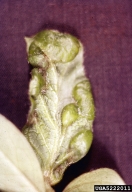 |
| Blister blight |
|
Crop duration and harvest
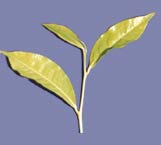 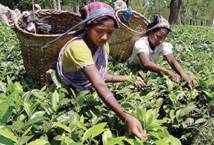 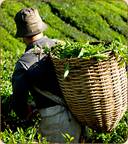
Banji bud Harvesting in tea
Plucking commences when the tea bush is 3 years old. The plucking of extreme tip of the growing branch consists of an unopened bud together with two leaves is popularly known as "Two leaves and a bud", while fine plucking is anything less than this. In South India plucking continues throughout the year at weekly intervals during March - May and at intervals of 10 -14 days during the other months.
Rush period
During rush period harvesting is done at 7 to 10 days interval.
Lean period
During lean period harvesting is done at 10 – 15 days interval.
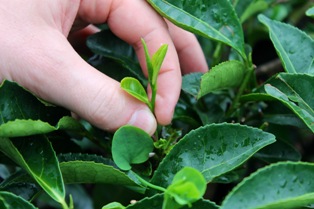 |
 |
| Banji bud |
 |
 |
| Harvesting in tea |
Freshly Picked Tea Leaves
|
 |
| Plucking Standard |
Yield
The yield of green leaves is 10 t/ha
Tea processing
India mainly process three types of tea viz., Crush, Tear and Curl (CTC) tea, Orthodox tea and Green tea.
CTC Method (Crushing, Tearing and Curling)
Withering (partial removal of moisture)
Withering is carried out to prepare the green tea shoots biochemically and physically for subsequent manufacturing operations. Withering essentially
consists of storage of green shoots for about 12 to 20 hours with the partial removal of moisture (known as physical wither) from the leaf. Withering is accompanied by certain chemical changes (known as chemical wither) which may affect fermentation and thereby, the quality of the final product. Chemical wither is essentially a time temperature dependent process. Some of these
changes are dependent on moisture loss while others are independent.
 |
| tea withering |
a) Natural Withering: The fresh tea leaves are laid out in thin layers on tats staked one above another and dried in the fresh air for at least 20 hours.
b) Artificial Withering: The leaves are laid out in layers of up to 20 cm. thick on a mesh. The meshes are placed in a tunnel; through which warm air mixed with fresh air is forced. This considerably reduces the total withering time. Around 70% residual moisture suitable for tea processing of the withered green leaves.
Rolling
Leaves processed using the CTC method are not rolled, but are placed through cylindrical rollers with small teeth. This machine consists of two separated metal rollers, placed close together and revolving at unequal speeds, which cut, tear and twist the leaf.
 |
| CTC rollers |
Rolling is the next step of manufacturing in which cell membranes are damaged allowing mixing of chemical components of leaves with enzymes. This technique is also known as maceration.
1. It is known as preconditioning roll.
2. This roll is usually very gentle.
3. During rolling the temperature should never be rises beyond 35ºC (95ºF). Temperature higher than 35ºC detrimental (TR formation) to the quality of made tea.
Fermentation/ oxidation (biochemical reactions in the presence of oxygen)
During fermentation, the oxidation process which had begun during rolling is continued. Fermentation takes place in separate fermentation rooms, which need to be kept extremely clean to avoid bacterial infection of the tea. In present days, Continuous Fermenting Machine (CFM) is widely used for fermentation in tea industries. It consists of single circuit of trays, top run of which passes through the fermenting chamber. Trays exposed at the feed end take their leaf load through a conveyer and are made to travel slowly.
 |
| Tea fermentation |
The tray fed up to 15 cm depth with rolled leaf entering the fermenting chamber through which humidified air is supplied. A spreader and leveler are used to adjust the spread and height of thickness. As soon as the tea has acquired a copper red colour, the correct degree of fermentation has been reached, and the process must be halted by drying. The fermenting chamber can be a single unit or may consist of modules with arrangement of blowing air across. The fermenting time can be regulated by adjusting the tray speed.
Heating and drying (completion of moisture
removal)
During drying the polyphenol oxidize enzyme should be properly inactivated and the desirable properties are fixed. The moisture content should be reduced to 3.5% whereby the aroma becomes established and the leaves chlorophyll is converted to phaeophytin which has taken on their typical black colouration. It helps in bonding of polyphenols with the protein and brings down the astringency.
Drier temperature
Inlet temperatures: 205ºF-265ºF
Outlet temperatures: 95ºF-113ºF
Difference between inlet and outlet temperature should be 90 ?F .
Sorting and grading (fibre removal; grading
based on size)
1. The CTC bulk is passed through a fiber extractor and a pre-sorter.
2. From pre-sorter tea goes to the Vibro Screen Sorter.
3. Different grades of CTC tea will come out through different mesh of Vibro screen sorter.
Mesh size & different grades are given below
Mesh size & different grades are given below
Mesh Size |
Grade
|
Above 8 |
Large ball |
10 |
BOPL
|
14 |
BOPSM |
18 |
BP |
24 |
OF |
30 |
PD |
36 |
D |
50 |
CD |
Gapping
During the process of sorting and bulking tea picks up moisture and it reaches above 4%. Before packaging it is detrimental. It is therefore necessary to final fire the tea in order to bring down the moisture content to about 3%. This process is known as ‘gapping’. Drying of tea for 10 min at 2200F before packaging is essential.
Packing and transporting
Tea should never be forced down by hand.
The CTC teas made from withered teas, damage will be more. It should be handled carefully.
Tea should be packed full otherwise oxygen in the free space activate the enzymes, the quality will deteriorate.
During packing moisture percentage, should not be more than 4%, preferably 3% during packing.
Orthodox tea
Orthodox tea is also very popular and widely consumed. Orthodox teas are rolled with machinery in a manner that mimics hand-rolling. All whole-leaf tea is made with orthodox production methods. Orthodox teas are known for its distinctive flavor and taste. Orthodox tea is mainly produced in Darjeeling hills in India.
Assam and South India also produce some amount of orthodox tea.
Orthodox Tea processing
Withering
Withering is carried out by spreading the leaves thinly on withering trough. It is made of tightly stretched wire-mesh, weld-mesh and netlon. The leaves are unloaded very carefully into the withering troughs. Leaves are to be categorized according to its size and quality. The leaves are kept 16-18 hours in withering trough with normal air according to temperatures. Light cooled air is passed below the withering trough during warm weather and lower elevation leaves. Hot air is required for higher elevation leaves and during rainy season. In case of orthodox tea manufacture in the plains wither should be aimed to achieve 60- 65% moisture. After withering leaves are transferred smoothly and gently for rolling. Because the rough handling of leaves will break the leave and degrade the quality. Withering depends on moisture level, leaf size and temperature.
Rolling
After a satisfactory withering obtained the leaves are ready for rolling in orthodox rolling machine. It twists the leaf, breaks it up and expresses the juices. Leaves are placed gently to the roller. Rolling time differs 20 minutes loose roll to 120 minutes roll as per leaf condition and temperature. After proper rolling leaves are transferred from roller to shifter in case of rough leaf. The used machines vary in size and design.
 |
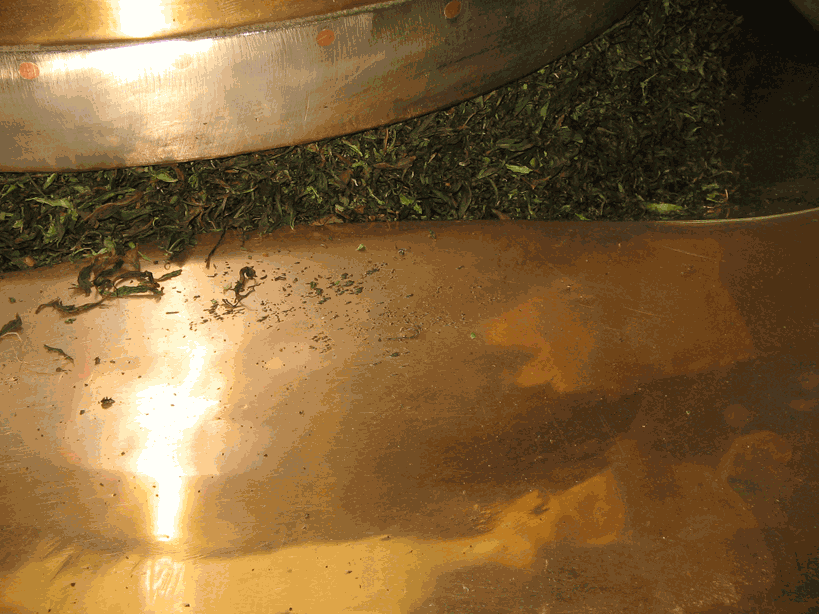 |
orthodox tea processing machine |
rolling - orthodax method Tea |
Shifter:
After rolling the leaves are transferred to the shifter. The fine leaves are going for fermentation and bulk formation was goes for rolling again.
Fermentation:
The next stage after shifter is fermentation. The rolled leaves which are passes through shifter are sifted for fermentation in Tray fermentation or Table fermentation. Fermentation depends on temperature and it may vary as per session. During fermentation, the leaves change their colour and turn into a dark coppery colour and typical aroma develops at this stage. The ideal conditions for fermentation are leaves temperature 30°C, moisture 55%, pH 4.5 to 5.0 and relative humidity 75% to 80% with a difference of 2° in wet bulb & dry bulb. When the sufficient colour and typical aroma develops (nose assessment) then fermentation is judged to be completed.
Drying/Firing:
The fermented leaves are transferred to drying machine for drying/firing. Endless chain pressure driers (ECP) commonly used in orthodox tea manufacturing. The fermented tea dried / fired up to 22-25 minutes. The ideal temperature of the drier is 220°F – 250°F and difference between inlet and outlet temperature should be 90°F. The other types of driers which are also used in orthodox tea manufacturing are hot-feed drier, fluid-bed drier and ding dong drying machine. Ding dong drying machine is used for small amount of leaves and it is difficult to operate.
Sorting and grading:
Sorting machines:
Arnott sorter: The dried leaves are introduced in Arnott sorter and the fine leaves are coming out. Mydleton sorter: It performs the grading operations and makes tea stalks free. Vibro fibre extractor: It separates the stalk part from the tea. Magnetic sorter: It removes the magnetic materials from the tea.
Different grades of Orthodox Tea:
Whole leaf:
FP- Flowery Pekoe
FTGFOP- Fine Tippy Golden Orange Pekoe
TGFOP1- Tippy Golden Orange Pekoe
GFOP- Golden Flowery Orange Pekoe
FOP- Flowery Orange Pekoe
OP- Orange Pekoe
BOP- Broken Orange Pekoe one
GFBOP- Golden Flowery Broken Orange Pekoe
Brokens:
BPS- Broken Pekoe Souchong
GBOP- Golden Broken Orange Pekoe
FBOP- Flowery Broken Orange Pekoe
BOP- Broken Orange Pekoe
GOF- Golden Orange Fannings
Fannings:
FOF- Flowery Orange Fannings
BOPF- Broken Orange Pekoe Fannings
OPD- Orange Pekoe Dust
OCD- Orange Churamani Dust
BOPD- Broken Orange Pekoe Dust
BOPFD- Broken Orange Pekoe Fine Dust
Dust:
FD- Fine Dust
D. A- Dust A
Spl. Dust- Special Dust
G. Dust- Golden Dust
Packing:
Packing is done in paper sacks with 4-5 layers of inner lining to restore the quality and avoid any moisture loss. Packing is usually done in 18 kg to 30 kg depending upon the volume. Small packing of 2 kg, 5 kg and 10 kg are also made as Darjeeling teas are very expensive. Sometimes good quality teas are packed in good looking wooden boxes after packing in paper sacks.
Green tea
Green tea is the most popular and widely consumed compare to other types of tea. Green tea is unfermented or un-oxidized tea and manufactured in such a manner that oxidation of green leaf polyphenols is prevented. It is originated from China. It has recently become more widespread in those countries where black tea is manufactured. Polyphenols, amino acids, Theaflavin (TF), Flavanols, Catechins, caffeine and Volatile flavor components are generally present in Green tea.
 |
| Different Types of Tea |
 |
 |
Black Tea |
Green Tea |
 |
 |
| Black Tea |
Oolong Tea |
 |
| Tea Grades |
 |
Tea Processing Steps |
Market Information
Growing Districts |
Nilgiris, Coimbatore, Dindigul, Theni, Kanyakumari and
Tirunelveli districts |
Major markets in Tamil Nadu |
Coimbatore, Nilgiris |
Grade specification |
Size of the tea leaves : Whole, large tea – Higher
grading
Method of production : CTC process (Crush, Tear and
Curl) and Orthodox |
 |
Tea Seed |
|






























